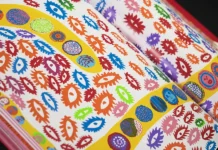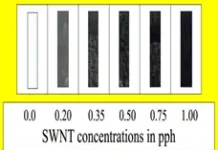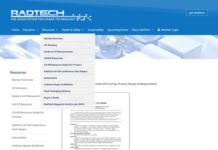1. As UV LEDs enter their teenage years, how have they changed, and what can you share about dealing with them?
Jennifer: In 2007, when I began working with UV LEDs, there were few practical applications. Early LED systems mainly were used in formulation labs, with R&D efforts focused on spot cure (adhesive structural bonding) and printing (digital inkjet pinning and eventually full-cure) applications. There were many in the industry who doubted whether UV LED technology could be a viable replacement for mercury lamps and believed the technology was limited to a few markets.
LEDs improved over the next five years. Irradiance (W/cm2) levels increased tremendously but often were still on the edge of what was needed for surface chemistry crosslinking. Energy density (J/cm2) levels also limited line speeds and part cycle times. This was compounded by the high cost, short lifetimes and cooling demands of UV diodes that made higher power lamp heads and longer length arrays economically difficult to justify.
Teenaged UV LEDs of 2021 are far superior and emit more than enough irradiance for UV curing applications when compared to their younger versions. A renewed focus on the role of energy density combined with proper integration and optimized formulations are enabling converting line speeds of 1000 to 1500 fpm and greater. Like a teenager, today’s LED lamp heads have grown and are being manufactured in single, continuous lamp head lengths up to 67 inches (1.7 meters).
Rob: We feel that LED curing is the present and future of UV curing. If you have a new UV project and have not considered LED, you are making a mistake. There are relatively few applications remaining where LED is not viable at least from a process standpoint. In terms of reliability, cooling is critical and a big performance differentiator among commercially available UV LED systems. The individual diodes are sensitive electronics that must maintain a factory-specified operating temperature and always be kept clean and dry. The LEDs should be sealed from the industrial environment and never exposed outside of a manufacturer’s clean room.
Despite the progress, UV LED technology – like a teenager – is far from mature. Performance and reliability differences exist between manufacturers, and headline-grabbing specifications, such as irradiance and quoted lifetimes, do not give a proper indication of real-world performance or reliability. Investigate the technical details of a system and clarify how the specifications translate to your application. The integration of an LED system into a printing or coating process is just as important as the LED emitter itself. Look beyond the LED head and consider how all systems are seamlessly integrated as a complete solution.
2. What LED features are considered “need to have”?
Rob: LED systems must be designed and matched to the application. Make sure the system selected delivers the needed energy density (J/cm2) and irradiance (W/cm2), as this will impact line speeds and cure performance. For industrial environments, you need sealed windows, sufficient and well-engineered thermal transfer/cooling, and industrial rated connectors. Power supplies, lamp heads and even mounting brackets need to be robust and engineered for the application and machine.
3. What LED features are nice to have?
Rob: Our customers increasingly appreciate remote system monitoring. IoT technologies are becoming standard issue on industrial equipment and are increasingly specified as a product requirement. Remote monitoring offers many advantages as it allows GEW to commission equipment, update software, monitor system performance data, troubleshoot technical issues and correct processes without having to be physically on site.
When investing in a UV LED system, ask if the equipment is supported by reliable power and control systems. If something happens, how quickly can the supplier diagnose and repair the issue? Remote monitoring is an efficient, timely and cost-effective tool that, while initially is nice to have, quickly becomes something many users are not willing to run without.
4. What advice do you have for customers looking to adopt a teenager-transition to LEDs?
Rob: If you have the right partners, there is no need to be afraid. LEDs transform the productivity and cost of your printing or coating process and, when done right, offer benefits over traditional broadband UV technology.
Irradiance (W/cm2) is not the most important characteristic of an LED system. Once a system emits above a minimum threshold (e.g., 16 W/cm2 at the emitting window for many web applications), then energy density (mJ/cm2) is the key performance driver. Coordinate with your supplier to match the energy density to the desired line speed. Do not judge an LED system on irradiance alone!
When a UV LED diode is properly cooled and powered, it easily can last 50,000 hours or more. However, there are two things that will kill LEDs in no time.
Poor cooling: This occurs when filters are clogged, water or airflow is interrupted, or the manufacturer has not adequately designed the cooling system for an industrial environment, as well as the system’s running conditions.
Contamination: Individual LEDs and modules should be sealed, remain completely clean and never be exposed outside of the manufacturer’s clean room. Ingress of foreign materials creates hotspots and harms electronics, both of which compromise the integrity of the device.
Integration onto the machine often is as important as the UV emitter itself. Look for a partner with industry experience, strong mechanical capability and application knowledge. Many good LED systems fail because they have been poorly specified for the application and/or hastily or carelessly integrated onto the machine.
5. Are there common characteristics that make the transition process to LEDs easier?
Jennifer: Formulations also have improved, and there are an increasing number of options. Ensure that the formulations and LED curing system work together for the specified application, material handling and end-use product. A successful change always involves collaboration, getting good advice and after-sale support from team partners.
Rob: Dual-cure ink and varnish sets, which cure when exposed to either a mercury or LED source, are increasingly available. Separate formulation sets were an early barrier to LED adoption. Using a dual-cure formulation eases the transition by eliminating this hurdle and reducing the number of SKUs. This saves time and cost and reduces uncertainty.
6. What are your thoughts on transitioning with and acquiring individual parts (LED head, power supply, cooling) vs. turning to a supplier that provides an integrated solution?
Rob: When you buy a car, you do not expect to choose a Ford engine, a Chevrolet gearbox and a BMW chassis and put them together yourself. This is because the car manufacturer designs, integrates and tests all components to work together and is the expert at doing so. The same principles apply to curing systems. A UV LED system is about far more than just the lamp head assembly. The long-term reliability and fitness for use is just as much the result of the power supply, the controls, the cooling system and the mechanical integration.
7. What questions need to be asked of formulators?
Jennifer: Start discussions with your incumbent suppliers. For existing mercury lines, it is important to determine how many of the formulations currently being used are available in an LED or dual-cure equivalent. Areas that are still in various stages of development include low-migration offerings; functional coatings, such as silicone release, hardcoats, topcoats and surface coats; and formulations designed to adjust coefficient of friction (COF) surface properties. How active and committed is your incumbent supplier to developing LED offerings that are not yet off-the-shelf? End users should clearly communicate specific requirements and anticipated demand early in the conversation. The adage of the squeaky wheel gets the grease holds true even here.
Once you have something, be engaged and test. Test in the lab, test on pilot lines and test on the press. Seeing is believing. Be ready to work and communicate with your supply team. Adjust the formulation, process, equipment and LED power level as needed.
Rob: A conversation around energy density and irradiance is key. Both the formulator and lamp supplier should be able to answer these questions and provide application guidance. If your formulator is using a specific LED configuration in their lab or on a pilot line, it does not mean a different LED specification will not work. For example, if they use 385 nm in the lab, then a 395 nm lamp may work equally well in production. Or if the irradiance of your lab source is particularly high, a lower irradiance lamp often can work just as well if its energy density is significantly higher. The formulator and lamp supplier should be knowledgeable of the interplay between wavelength, irradiance and energy density and how it translates to successful curing in a manufacturing environment.
8. What role does UV measurement play in the process?
Rob: Measurement is critical for establishing a baseline operating window on day one. When or if something goes wrong in the future, how will you know what variable changed if you did not measure your process when it was working? It also is important to have regular technical conversations between yourself and your suppliers. Your UV curing process is initiated by UV energy. If you do not have the ability to measure that UV energy, you and your suppliers are shooting in the dark when problem solving.
For more information, contact Rob Rae (rrae@gewuv.com) and Jennifer Heathcote (jheathcote@gewuv.com).






